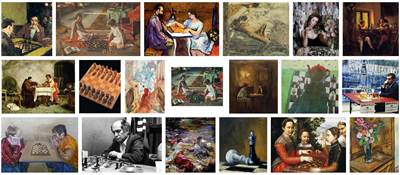Chess and Impressionism
After my first idea for today's post ran into trouble when I ran out of time (a follow-up to last week's A Remarkable Tool, if you're curious), I flipped back to last year's Chess and Art Movements (December 2017; 'chess cubism'), where I wrote,
With so many recognized art periods, there is plenty of source material here. I'll come back to the subject the next time I'm looking for an idea for my daily post.
When it comes to art movements, impressionism is one of the best known.

Google image search on 'chess impressionism'
[Call the rows 'A' to 'C' (from top to bottom) and number the images in each row '1' to '6' (from left to right).]
That's an interesting collage of images, but they don't all seem to be about chess. Take A4, for example, which leads to From Man Ray’s chess set to Dalí’s Arabian nights, subtitled, '11 fascinating works for under £100,000 -- offered across three different sales of Impressionist & Modern Art during 20th Century at Christie’s London'. The A4 image ('1. Touched by the finger of Bonnard') happens to be the first image on that page. Further down is '10. Surrealist chess', also shown in B2, a Man Ray chess set in a double image, with the chess set on the left:-
Chess became a passion and a ritual for Man Ray after his rooftop encounter with chess fanatic Marcel Duchamp in New York in 1924. The pair, who were great friends, would often play throughout the night, believing that games allowed them to explore the repressed desires of the unconscious. Man Ray designed his first chess set in 1920, with found objects from his studio. [...] Man Ray perceived the chessboard as a surrealist object.
What about the C2 image -- what does a photo of Mikhail Tal have to do with impressionism? The title of the source page explains, Tal Memorial in Museum of Russian Impressionism (gamesmaven.io/chessdailynews), where the Tal Memorial is a world-class chess tournament.
As for the real chess images in the Google collage, A1 is found on The Progressive Era : Art. Unfortunately, neither the artist nor the work is identified and my attempts to identify them turned up nothing.
A2 is the first of four images from Pinterest, a resource which used to be nearly worthless for instructional value, where links only led to pages with dozens, sometimes hundreds, of poorly identified images. The A2 image (also seen in B3) leads to The Chess Players - Sir John Lavery 1929 Impressionism Tate Gallery, London, UK.
A3 leads to an even more informative page: Alexandru Ciucurencu (Romanian, Post-Impressionism, 1903–1977). Here the work is identifed as 'The Chess Players', oil on cardboard, 61 x 91 cm, Brukenthal National Museum, Sibiu, Romania.
I could continue to walk through more of the images returned by Google, but I'll stop here. I'll try to return to 'A Remarkable Tool' in another post.




No comments:
Post a Comment